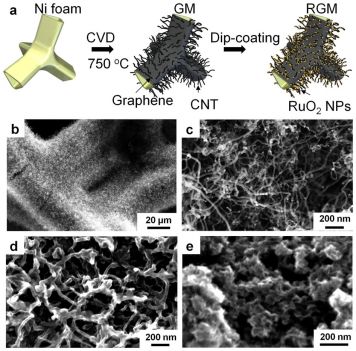Improved Supercapacitors for Super Batteries, Electric Vehicles

(a) Schematic illustration of the preparation process of RGM nanostructure foam. SEM images of (b–c) as-grown GM foam (d) Lightly loaded RGM, and (e) heavily loaded RGM.
Researchers at the University of California, Riverside have developed a novel nanometer scale ruthenium oxide anchored nanocarbon graphene foam architecture that improves the performance of supercapacitors, a development that could mean faster acceleration in electric vehicles and longer battery life in portable electronics.
The researchers found that supercapacitors, an energy storage device like batteries and fuel cells, based on transition metal oxide modified nanocarbon graphene foam electrode could work safely in aqueous electrolyte and deliver two times more energy and power compared to supercapacitors commercially available today.
The foam electrode was successfully cycled over 8,000 times with no fading in performance. The findings were outlined in a recently published paper, “Hydrous Ruthenium Oxide Nanoparticles Anchored to Graphene and Carbon Nanotube Hybrid Foam for Supercapacitors,” in the journal Nature Scientific Reports.
The paper was written by graduate student Wei Wang; Cengiz S. Ozkan, a mechanical engineering professor at UC Riverside’s Bourns College of Engineering; Mihrimah Ozkan, an electrical engineering professor; Francisco Zaera, a chemistry professor; Ilkeun Lee, a researcher in Zaera’s lab; and other graduate students Shirui Guo, Kazi Ahmed and Zachary Favors.
Supercapacitors (also known as ultracapacitors) have garnered substantial attention in recent years because of their ultra-high charge and discharge rate, excellent stability, long cycle life and very high power density.
These characteristics are desirable for many applications including electric vehicles and portable electronics. However, supercapacitors may only serve as standalone power sources in systems that require power delivery for less than 10 seconds because of their relatively low specific energy.
A team led by Cengiz S. Ozkan and Mihri Ozkan at UC Riverside are working to develop and commercialize nanostructured materials for high energy density supercapacitors.
High capacitance, or the ability to store an electrical charge, is critical to achieve higher energy density. Meanwhile, to achieve a higher power density it is critical to have a large electrochemically accessible surface area, high electrical conductivity, short ion diffusion pathways and excellent interfacial integrity. Nanostructured active materials provide a mean to these ends.
“Besides high energy and power density, the designed graphene foam electrode system also demonstrates a facile and scalable binder-free technique for preparing high energy supercapacitor electrodes,” Wang said. “These promising properties mean that this design could be ideal for future energy storage applications.”
Media Contact
Sean Nealon
Tel: (951) 827-1287
E-mail: sean.nealon@ucr.edu
Twitter: seannealon
Additional Contacts
Cengiz Ozkan
Tel: 951-827-5016
E-mail: cozkan@engr.ucr.edu
Media Contact
More Information:
http://ucrtoday.ucr.edu/22587All latest news from the category: Power and Electrical Engineering
This topic covers issues related to energy generation, conversion, transportation and consumption and how the industry is addressing the challenge of energy efficiency in general.
innovations-report provides in-depth and informative reports and articles on subjects ranging from wind energy, fuel cell technology, solar energy, geothermal energy, petroleum, gas, nuclear engineering, alternative energy and energy efficiency to fusion, hydrogen and superconductor technologies.
Newest articles

A universal framework for spatial biology
SpatialData is a freely accessible tool to unify and integrate data from different omics technologies accounting for spatial information, which can provide holistic insights into health and disease. Biological processes…

How complex biological processes arise
A $20 million grant from the U.S. National Science Foundation (NSF) will support the establishment and operation of the National Synthesis Center for Emergence in the Molecular and Cellular Sciences (NCEMS) at…

Airborne single-photon lidar system achieves high-resolution 3D imaging
Compact, low-power system opens doors for photon-efficient drone and satellite-based environmental monitoring and mapping. Researchers have developed a compact and lightweight single-photon airborne lidar system that can acquire high-resolution 3D…





















